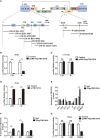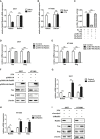Novel Host Protein TBC1D16, a GTPase Activating Protein of Rab5C, Inhibits Prototype Foamy Virus Replication
- PMID: 34367131
- PMCID: PMC8339588
- DOI: 10.3389/fimmu.2021.658660
Novel Host Protein TBC1D16, a GTPase Activating Protein of Rab5C, Inhibits Prototype Foamy Virus Replication
Abstract
Prototype foamy virus (PFV) is a member of the oldest family of retroviruses and maintains lifelong latent infection in the host. The lifelong latent infection of PFV may be maintained by the restriction factors of viral replication in the host. However, the mechanisms involved in PFV latent infection are poorly understood. Here, we found that TBC1D16, a TBC domain-containing protein, is significantly down-regulated after PFV infection. Tre2/Bub2/Cdc16 (TBC) domain-containing proteins function as Rab GTPase-activating proteins (GAPs) and are participates in the progression of some diseases and many signaling pathways. However, whether TBC proteins are involved in PFV replication has not been determined. Here, we found that TBC1D16 is a novel antiviral protein that targets Rab5C to suppress PFV replication. Overexpression TBC1D16 inhibited the transcription and expression of Tas and Gag, and silencing TBC1D16 enhanced the PFV replication. Moreover, the highly conserved amino acid residues R494 and Q531 in the TBC domain of TBC1D16 were essential for inhibiting PFV replication. We also found that TBC1D16 promoted the production of PFV-induced IFN-β and the transcription of downstream genes. These results suggest that TBC1D16 might be the first identified TBC proteins that inhibited PFV replication and the mechanism by which TBC1D16 inhibited PFV replication could provide new insights for PFV latency.
Keywords: Rab5C; TBC1D16; prototype foamy virus (PFV); type I IFN; viral replication.
Copyright © 2021 Yan, Zheng, Yuan, Wang, Han, Yin, Peng, Li, Sun, He and Liu.
Conflict of interest statement
The authors declare that the research was conducted in the absence of any commercial or financial relationships that could be construed as a potential conflict of interest.
Figures








Similar articles
-
Retroviral foamy virus gag induces parkin-dependent mitophagy.Retrovirology. 2025 May 2;22(1):7. doi: 10.1186/s12977-025-00664-3. Retrovirology. 2025. PMID: 40317036 Free PMC article.
-
VCY mediates inhibition of PFV replication via interaction with the transcription activator Tas.J Virol. 2025 Jul 22;99(7):e0016625. doi: 10.1128/jvi.00166-25. Epub 2025 Jun 3. J Virol. 2025. PMID: 40459262 Free PMC article.
-
N-Myc interactor inhibits prototype foamy virus by sequestering viral Tas protein in the cytoplasm.J Virol. 2014 Jun;88(12):7036-44. doi: 10.1128/JVI.00799-14. Epub 2014 Apr 9. J Virol. 2014. PMID: 24719420 Free PMC article.
-
Bovine Foamy Virus: Shared and Unique Molecular Features In Vitro and In Vivo.Viruses. 2019 Nov 21;11(12):1084. doi: 10.3390/v11121084. Viruses. 2019. PMID: 31766538 Free PMC article. Review.
-
Non-simian foamy viruses: molecular virology, tropism and prevalence and zoonotic/interspecies transmission.Viruses. 2013 Sep 13;5(9):2169-209. doi: 10.3390/v5092169. Viruses. 2013. PMID: 24064793 Free PMC article. Review.
Cited by
-
Retroviral foamy virus gag induces parkin-dependent mitophagy.Retrovirology. 2025 May 2;22(1):7. doi: 10.1186/s12977-025-00664-3. Retrovirology. 2025. PMID: 40317036 Free PMC article.
-
TBC1D18 is a Rab5-GAP that coordinates endosome maturation together with Mon1.J Cell Biol. 2022 Dec 5;221(12):e202201114. doi: 10.1083/jcb.202201114. Epub 2022 Oct 5. J Cell Biol. 2022. PMID: 36197338 Free PMC article.
-
VCY mediates inhibition of PFV replication via interaction with the transcription activator Tas.J Virol. 2025 Jul 22;99(7):e0016625. doi: 10.1128/jvi.00166-25. Epub 2025 Jun 3. J Virol. 2025. PMID: 40459262 Free PMC article.
-
Functional genomics screens reveal a role for TBC1D24 and SV2B in antibody-dependent enhancement of dengue virus infection.J Virol. 2024 Nov 19;98(11):e0158224. doi: 10.1128/jvi.01582-24. Epub 2024 Oct 8. J Virol. 2024. PMID: 39377586 Free PMC article.
-
PREB inhibits the replication of prototype foamy virus by affecting its transcription.Virol J. 2023 Oct 26;20(1):244. doi: 10.1186/s12985-023-02211-y. Virol J. 2023. PMID: 37885034 Free PMC article.
References
Publication types
MeSH terms
Substances
LinkOut - more resources
Full Text Sources
Molecular Biology Databases

